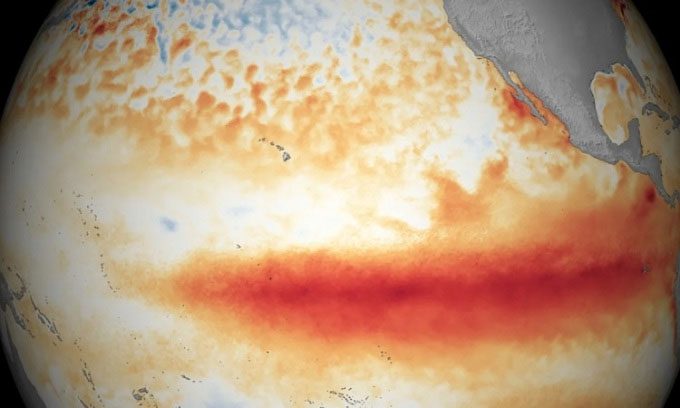The World Meteorological Organization (WMO) warns that a strong El Niño is expected to develop in the coming months, and human-induced climate change will push temperatures to unprecedented highs, reaching new records within the next five years.
Global temperatures are likely to exceed the 1.5 degrees Celsius threshold set by the Paris Agreement within the next five years, according to a report from the United Nations (UN). The WMO issued this warning in its latest annual assessment. According to the WMO, there is a 66% chance that annual global surface temperatures will rise more than 1.5 degrees Celsius above pre-industrial levels. This would mark the first time in human history that such a significant increase has been recorded.

Pacific temperatures rise due to strong El Niño in January 2016. (Photo: NOAA).
Scientists warn that exceeding the 1.5 degrees Celsius threshold will increase the risk of reaching tipping points, which could trigger irreversible climate change effects, such as the collapse of the Greenland and Antarctic ice sheets, extreme heat waves, severe droughts, water shortages, and extreme weather events across vast regions of the world.
About 200 countries have committed to limiting global temperature increases to 1.5 degrees Celsius or lower under the 2015 Paris Agreement. However, this threshold may be exceeded for the first time, even if only temporarily.
According to Petteri Taalas, the WMO Secretary-General, the anticipated warm El Niño developing in the coming months will combine with human-induced climate change, pushing global temperatures to unprecedented levels. This will result in widespread consequences for health, food security, water management, and the environment.
El Niño occurs when trade winds (which typically push warm water westward across the Pacific from South America to Asia) weaken, leading to warmer water accumulating in place. This phenomenon significantly impacts climate patterns worldwide, making South America wetter and bringing drought to regions such as Australia, Indonesia, northern China, and northeastern Brazil. In the United States, El Niño tends to result in warmer and drier conditions in the north, while the south becomes wetter as warm water spreads and is located closer to the surface, heating the air above.
The latest WMO report examines the period from 2023 to 2027. It indicates that there is a 98% chance that one year within this timeframe will set a new record for the hottest year, exceeding the 1.28 degrees Celsius increase recorded in 2016. The likelihood of global temperatures rising above the 1.5 degrees Celsius threshold was nearly 0% in 2015, 48% in 2022, and has increased to 66% in 2023. Researchers note that global warming is not uniform. For example, the Arctic is expected to experience temperature changes three times greater than other regions, driving ice melt and significantly impacting climate systems such as the jet stream and North Atlantic currents, which play a crucial role in regulating temperatures in the Northern Hemisphere.
Meanwhile, rainfall is expected to decrease in Central America, Australia, Indonesia, and the Amazon. Deforestation, climate change, and wildfires have led to the massive rainforests losing their ability to recover since 2000, potentially transitioning into grasslands.




















































